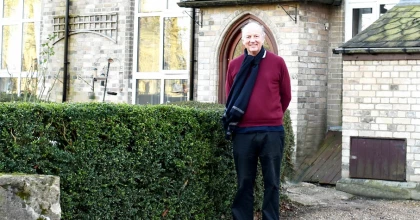The Depperhaugh’s connection to 19th century admiral is brought into focus


The descendant of a 19th century admiral has made a first pilgrimage to his Suffolk home during research for a new biography to tell his remarkable life story. With military precision Admiral Sir Baldwin Walker oversaw the building of his dream family home in Chickering Road, Hoxne, near Eye, as his meteoric Royal Navy career drew to a close in the 1860s. His great great grandson, Richard Wake-Walker, travelled from his home in Wimbledon to take photographs of what is now The Depperhaugh nursing home and to look at the features designed and beloved of the admiral such as its striking Victorian walled garden.
He also visited Hoxne churchyard where the admiral is buried and the church in neighbouring Oakley where he wed Mary Worth, the daughter of a Navy officer, in 1834. The couple had 11 children, eight of whom survived beyond the age of three, and it was this Suffolk connection which drew them to Hoxne to build their retirement home. Mr. Wake-Walker, 66, who runs a mining consultancy firm, has a lifelong passion to revive the memory of the admiral and aims to complete his research and publish the book in 2026 to mark the 150th anniversary of his death. The life prospects for Baldwin Walker, who was born in 1802 and brought up on the Isle of Man, first looked extremely bleak with an alcoholic father who was always in debt and ended up in prison. Mr Wake Walker said: “It was that background which led him to join the Navy as a volunteer at the age of 10. “However, although he had little of the patronage which helped naval officers of that era gain promotion, he was able to rise through the ranks through fine seamanship, ability, leadership and devotion to the service.”
During a career that took him to all parts of the globe, his greatest humanitarian achievement came during his time as commander in chief Cape of Good Hope when he helped to eradicate slavery along the East coast of Africa. “The African West coast had attracted much more attention in Britain and slavery there had already largely been eliminated with Walker playing a part as a young officer. “However, French, Portuguese and maritime Arab slavers then moved to Mozambique, Madagascar and Zanzibar until Walker deployed his Cape squadron to intercept them and destroy their business,” said Mr. Wake-Walker, whose mother Lady Anne Wake-Walker, 97 - aunt to the late Princess Diana - lives in East Bergholt, Suffolk. He said Admiral Walker’s biggest achievement had been to rebuild the sailing navy into a wooden steam navy for the Crimean War and then as an iron armoured navy to deter French aggression. “From 1848-1861, Baldwin Walker was Surveyor of the Navy, renamed Controller of the Navy during his tenure, and was responsible for all the Navy’s shipbuilding as well as the shipping and supplies for the Crimean War for which he was awarded a baronetcy,” he said. “His most famous contribution as Controller of the Navy was the proposal, planning and building of the largest, most powerful and technologically advanced warship of the day, HMS Warrior, which today is still moored at Portsmouth Historic Dockyard, attracting more than 300,000 visitors a year.”
Mr Wake-Walker was shown around the Kingsley Healthcare run home by manager Maxine Smith who said she was thrilled to have learned so much about the history of The Depperhaugh. “It’s clear that the admiral was a great man who deserves to be better remembered. At some stage in the future, it would be a fitting idea to work with others in the village to put on an exhibition in his memory,” she said.
Captions: Old images showing admiral supplied by Richard Wake-Walker. Fourth image shows admiral outside house with someone unidentified. Last image by Gordon Powles of Richard Wake-Walker.
Find more about Depperhaugh nursing care home in Hoxne, Diss
Click here to read more about Admiral Sir Baldwin Walker.
Author: Stephen Pullinger















